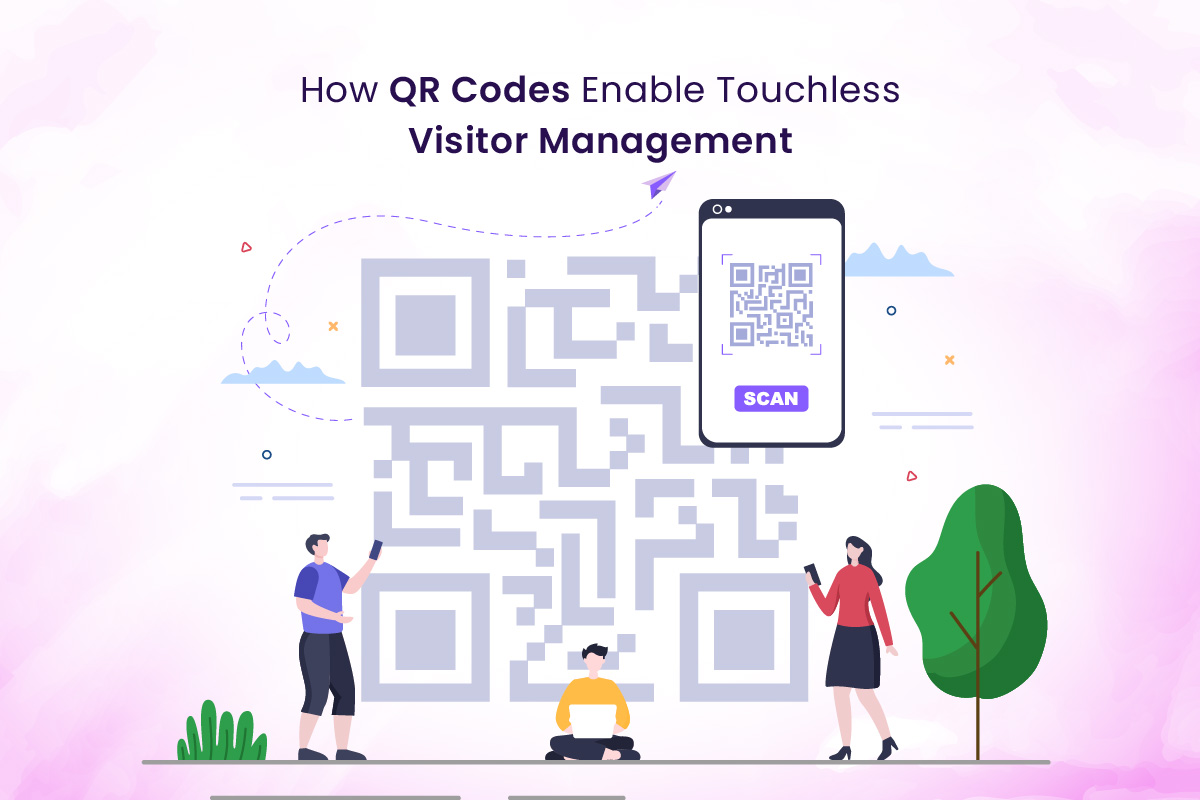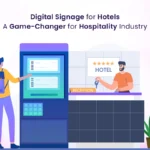
QR Codes and the Future of Touchless Visitor Management
Do you remember the time when you rushed to reception for your appointment? You arrived and saw there was a huge queue of other visitors waiting to get in. When your turn came, you entered your details, wrote down your host’s name in the guestbook, and entered the premises.
The above-mentioned scenario is of the pre-digital era at most corporate offices, schools, hospitals, restaurants, etc. However, today nobody would like to welcome their visitors in such a manner.
Digitalization of the workspace started in the early 1970s with office automation, computerized word processing, and the sending of the first email. Automated reception systems came later at the end of this century to improve front desk efficiency and to provide a better visitor experience.
However, it was the COVID-19 outbreak that gave a breakthrough to touchless visitor management developments such as the QR Code sign-in system.
QR-based visitor management systems are reshaping how organizations handle and welcome visitors. These systems use technology to make check-ins easier, cut down waiting times, and ensure accurate data. At the same time, they create a smooth process for visitors and staff alike.
Join us as we explore the advantages, functions, and practical uses of QR-powered visitor management. We will also learn about the key ideas and tech behind systems that let visitors sign in without touching anything.
What Does a QR Code Visitor System Do?
A QR code visitor management system is a tool that helps speed up and simplify how guests check-in. It uses Quick Response (QR) codes that people can scan with their phones or at kiosks to finish the process.
Main Features of QR Code Visitor Systems
Creating QR Codes: Visitors who register in advance get QR codes by email or text. These codes store important details like their name, reason for visiting, and contact info.
1. Check-in Without Contact:
- Fast and clean: By scanning QR codes on their phones, visitors avoid writing information by hand, keeping everything touch-free.
- No application needed: Visitors don’t have to install any app to use the QR code check-in.
2. Better Security:
- Individual QR codes: Each person is assigned their own QR code to block unauthorized entry.
- Verify identity: Systems can combine QR codes with tools like ID scans, face recognition, or one-time passcodes to boost safety.
3. Real-Time Tracking and Monitoring:
- See visitor movements: Keep track of everyone coming in and out.
- Visitor records: Store digital check-in details to meet rules and safety.
4. Application of QR Code Visitor System
- Corporate Offices: Make check-ins simple and smooth for visitors, clients, and contractors in a professional way.
- Educational Institutions: Organize and secure campus visits for parents, tours, and guests with ease.
- Healthcare Facilities: Keep visitor access safe and compliant to uphold care and confidentiality standards.
- Event Venues: Create easy and stress-free access for attendees, from arrival to entry.
How QR-Based Visitor Management Systems Work?
QR Code systems, also known as touchless visitor management systems, let visitors check in fast with their smartphones. When they arrive, they scan a QR code shown either at a kiosk or sent to them through email or text.
This quick interaction helps speed up check-ins and fits well with current security systems. It lets businesses keep strong security measures while making everything smoother and more efficient.
1. Signing Up and Making a QR Code
Pre-registration kicks off the process. Visitors get a QR code through email or SMS once they confirm their appointment. This QR code holds key details like the visitor’s name, their contact info, and the reason they are visiting. When visitors arrive, they scan the QR code either at a kiosk or through a specific app allowing them to check in right away.
2. Instant Updates and Managing Access
When someone scans the QR code, the system alerts the host right away about the visitor’s arrival. It can also work with access control systems to let visitors into certain areas depending on their permissions. This setup makes sure authorized people can enter restricted zones to improve safety.
3. Smooth Visitor Check-In Process
Upon arrival, visitors utilize their smartphones along with a QR code for check-in purposes. At the designated check-in location, which may be a kiosk or a mobile device, they proceed to scan the code. This scan records their arrival in the visitor management system. It removes the need to enter data and lowers the chance of mistakes. The process takes a few seconds. It speeds things up and makes the experience smooth for visitors.
4. Connecting with Access Control Systems
QR-based visitor systems or QR code sign-in systems work well with access control setups boosting security in organizations. After a visitor scans their QR code during check-in, the system determines which areas they can access using preset permissions. This connection with access control helps make sure people with the right clearance can go into restricted zones keeping secure areas and resources protected.
5. Stronger Security Options
QR-based visitor management systems focus on security. These systems include features like checking IDs, screening against watchlists, and using digital signatures. Checking IDs helps confirm a visitor’s identity. Screening against watchlists flags people who might be a threat. Some organizations might also require digital signatures to meet legal rules or enhance protection.
How Do QR Codes Support Touch-Free Visitor Check-Ins?
A digital receptionist today offers visitors two ways to check in without touching anything. They can scan a QR code or send a text message with a code. These options kick off the check-in process, which guests can finish on their phones without needing to download an app or connect to WiFi.
Another helpful tool is preregistration. This makes signing in faster by letting visitors register in just a few seconds after they arrive. You need to start a visit through your calendar, which sends the guest an invitation.
You can customize details by adding office directions, entry instructions, and more. Visitors can fill in necessary details like their name, their host’s name, and their purpose for visiting in advance. When they arrive at your office, they scan the QR code with their phone.
You can also create a unique QR code and share it with your visitors. Individuals have the option to either download it onto their mobile device or print it out for scanning upon their arrival at your office.
Why Does Contactless QR Sign-In Matter to Your Visitors?
In a competitive business world, putting in extra effort to impress your guests can play a big role in helping your organization thrive. Streamlining your front-desk operations and reducing staff interruptions from visitors leads to improved efficiency higher productivity, and better cost savings overall.
- It Leaves a Strong and Memorable Impact
People don’t stick with a business if they’ve had several bad encounters. After just one poor experience, many will take their business elsewhere. In fact, you might not get a second chance with two out of ten visitors.
How you greet and handle your guests plays a big role in leaving a solid first impression. This applies to everyone—whether it’s current or potential clients, vendors, or business partners. Using a top-quality visitor management tool that includes contactless QR code check-ins can show your company as reliable and worth working with. It can also make visiting your office feel like a great experience.
- You Can Protect Visitor Health and Privacy
Contactless QR code sign-ins let you avoid touching shared surfaces, which helps reduce the risk of spreading illnesses. A digital reception that you can adjust allows you to add features like temperature checks and visitor screening. This makes sure people who might endanger others’ health cannot enter your workplace.
QR codes refresh often to comply with privacy regulations. The QR code sign-in system also safeguards personal data, ensuring authorized individuals can access it.
- Use QR Code Reception Software to Avoid Overcrowding at Reception
QR code receptionist tools make checking in quick and easy. Pre-registration lets visitors finish the process fast and without hassle.
By notifying the host, visitors don’t need to wait in the lobby or stand at the desk by themselves. This setup removes the need for guests to deal with receptionists or staff. It creates an efficient experience that saves time for both your team and your visitors, while also ensuring guests feel attended to.
These advantages also give your business an edge. Happy visitors can mean stronger trust and more opportunities to bring in clients and partners.
Conclusion
In today’s busy world, managing visitors well is key for running things smoothly and enhancing security. It also helps create a good impression for guests. Touchless check-ins with QR codes provide an easy and secure way to handle this. These systems work well and come packed with useful features making them a top choice to transform how businesses manage visitors.
So, if you want to improve how your visitors feel about their experience, you should use a QR code contactless sign-in system. It can help you go beyond expectations while making things easier for guests and front-desk teams. This change can also boost how you work.




